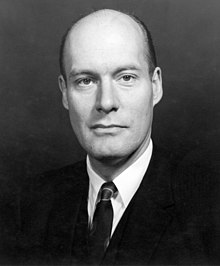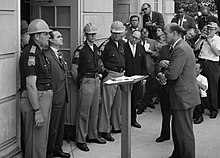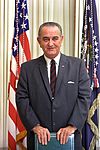Nicholas Katzenbach
Nick Katzenbach | |
|---|---|
 Katzenbach in 1962 | |
| 24th United States Under Secretary of State | |
| In office November 28, 1966 – January 20, 1969 | |
| President | Lyndon B. Johnson |
| Preceded by | George Ball |
| Succeeded by | Elliot Richardson |
| 65th United States Attorney General | |
| In office September 4, 1964 – November 28, 1966 Acting: September 4, 1964 – February 11, 1965 | |
| President | Lyndon B. Johnson |
| Deputy | Ramsey Clark |
| Preceded by | Robert Kennedy |
| Succeeded by | Ramsey Clark |
| 7th United States Deputy Attorney General | |
| In office April 16, 1962 – January 28, 1965 | |
| President | John F. Kennedy Lyndon B. Johnson |
| Preceded by | Byron White |
| Succeeded by | Ramsey Clark |
| Personal details | |
| Born | Nicholas deBelleville Katzenbach January 17, 1922 Philadelphia, Pennsylvania, U.S. |
| Died | May 8, 2012 (aged 90) Skillman, New Jersey, U.S. |
| Political party | Democratic |
| Spouse | Lydia King Phelps Stokes |
| Children | 4, including John |
| Relatives | Edward L. Katzenbach (father) Marie Hilson (mother) |
| Education | Princeton University (AB) Yale University (LLB) Balliol College, Oxford |
| Military service | |
| Allegiance | United States |
| Branch/service | United States Army |
| Unit | |
| Battles/wars | World War II |
Nicholas deBelleville Katzenbach (January 17, 1922 – May 8, 2012) was an American lawyer who served as United States Attorney General during the Lyndon B. Johnson administration. He previously served as United States Deputy Attorney General under President John F. Kennedy.
Early life and education
Katzenbach was born in
He was named after his mother's great-great-grandfather, Nicolas de Belleville (1753–1831), a French medical doctor who accompanied
He attended
He received his
.On June 8, 1946, Katzenbach married Lydia King Phelps Stokes, in a ceremony officiated by her uncle,
Katzenbach was admitted to the New Jersey bar in 1950 and the Connecticut bar in 1955. He was an associate in the law firm of Katzenbach, Gildea and Rudner in 1950.
Government service
From 1950 to 1952, he was attorney-advisor in the Office of General Counsel to the
He served in the
In September 2008, Katzenbach published Some of It Was Fun: Working with RFK and LBJ (W. W. Norton), a memoir of his years in Government service.
The "Stand in the Schoolhouse Door"

On June 11, 1963, Katzenbach was a primary participant in one of the most famous incidents of the Civil Rights struggle.
Role in JFK assassination investigation
Katzenbach has been credited with providing advice after the
Four days after Katzenbach's memo, Johnson appointed some of the nation's most prominent figures, including the
Later years
Katzenbach left government service to work for IBM in 1969, where he served as general counsel during the lengthy antitrust case filed by the Department of Justice seeking the break-up of IBM. He and Cravath, Swaine & Moore attorney Thomas Barr led the case for the computer giant for 13 years until the government finally decided to drop it in 1982. Later Katzenbach led the opposition against the case filed by the European Economic Community.
He retired from IBM in 1986 and became a partner at the firm of
In 1980, Katzenbach testified in the
In December 1996, Katzenbach was one of New Jersey's fifteen members of the Electoral College, who cast their votes for the Clinton/Gore ticket.[19]
Katzenbach also testified on behalf of President Clinton on December 8, 1998, before the House Judiciary Committee hearing, considering whether to impeach President Clinton.[20]
On March 16, 2004, MCI Communications in a press release[permanent dead link] announced "its Board of Directors has elected former U.S. Attorney General Nicholas Katzenbach as non-executive Chairman of the Board, effective upon MCI's emergence from Chapter 11 protection. Katzenbach has been an MCI Board member since July 2002." MCI later merged with Verizon.
Katzenbach was a member of both the American Academy of Arts and Sciences[21] and the American Philosophical Society.[22]
Katzenbach and his wife Lydia retired to the Princeton, New Jersey area, with a summer home on Martha's Vineyard in West Tisbury, Massachusetts.[23] His son is writer John Katzenbach. His daughter, Maria, is also a published novelist.[24]
After the death of W. Willard Wirtz in April 2010, Katzenbach became the oldest surviving former U.S. Cabinet member. Katzenbach died at his home in the Skillman section of Montgomery Township, New Jersey, on May 8, 2012, at the age of 90.[25]
See also
- Some of It Was Fun: Working with RFK and LBJ (W. W. Norton) – publisher web site
- Video: Nicholas Katzenbach talks about his youth (bigthink.com)
- Video: Nicholas Katzenbach on RFK and LBJ[permanent dead link] (bigthink.com)
- Video: Nicholas Katzenbach compares Vietnam and Iraq[permanent dead link] (bigthink.com)
- The Best and the Brightest
- Katzenbach appears in archival footage of his confrontation with Gov. Wallace in the movie Forrest Gump
References
- ^ Lineage Book, National Society of the Daughters of the American Revolution, Volume XXXV (1901).
- ^ "Trenton Old & New" Archived June 29, 2008, at the Wayback Machine, Trenton Historical Society. Accessed June 27, 2008.
- ^ "Current Biography Yearbook". H. W. Wilson Company. October 21, 1966. Retrieved October 21, 2017 – via Google Books.
- ^ "Background on Nicholas Katzenbach – Video". June 27, 2013. Retrieved October 21, 2017.
- ^ "New Attorney General; Nicholas deBelleville Katzenbach". The New York Times. October 21, 1965. Retrieved October 21, 2017.
- ^ a b Purdum, Tom (February 6, 2013). "Lives: Nicholas deB. Katzenbach '43". The Princeton Alumni Weekly.
- ISBN 9780881461251.
- ^ Letter from Katzenbach at TPM Cafe 2009 Archived March 24, 2012, at the Wayback Machine
- ^ Katzenbach, Nicholas de Belleville. Woodrow Wilson School of Public and International Affairs (ed.). "The Little Steel Formula - An Historical Appraisal".
{{cite journal}}: Cite journal requires|journal=(help) - ^ "CIVIL AND CRIMINAL CONTEMPT IN THE FEDERAL COURTS". The Yale Law Journal. 57 (83). Retrieved September 15, 2023.
- ^ "Nuptials are Held for Lydia Stokes", The New York Times, June 9, 1947. Accessed June 27, 2008.
- ISBN 9781416554820.
- ^ Andrew Cohen (May 9, 2012). "Nicholas Katzenbach, Unsung Hero of America's Desegregation". Theatlantic.com.
- ^ "Alabama segregation date approaches". USA Today. June 8, 2003. Retrieved November 23, 2007.
- ^ a b c d e Savage, David G. (May 10, 2012). "Nicholas Katzenbach dies at 90; attorney general under Johnson". Los Angeles Times. Los Angeles. Retrieved December 12, 2014.
- ^ a b c d e "Nicholas Katzenbach, JFK and LBJ aide, dead at 90". Politico. AP. May 9, 2012. Retrieved December 12, 2014.
- ^ "Riker Danzig firm history". Archived from the original on July 4, 2008. Retrieved October 21, 2017.
- ^ See Katzenbach, Nicholas (de Belleville) in John S. Bowman, ed., The Cambridge Dictionary of American Biography (Cambridge, England: The Cambridge University Press, 1995).
- ^ 1996 Electoral College Votes, accessed December 21, 2006
- ^ "Transcript: Statement of former Attorney General Katzenbach – December 8, 1998". www.cnn.com. Retrieved October 21, 2017.
- ^ "Nicholas DeBelleville Katzenbach". American Academy of Arts & Sciences. Retrieved March 28, 2022.
- ^ "APS Member History". search.amphilsoc.org. Retrieved March 28, 2022.
- ^ "Land Bank adds beach, pasture" Archived October 7, 2008, at the Wayback Machine, Martha's Vineyard Times, March 29, 2007. Accessed June 28, 2008.
- Washington Post. January 15, 1978. Retrieved March 3, 2020.
- ^ Martin, Douglas (May 10, 2012). "Nicholas Katzenbach, 90, Dies; Policy Maker at '60s Turning Points". The New York Times. p. B13. Retrieved June 21, 2023.
Bibliography
- Katzenbach, Nicholas (2008). Some of It Was Fun: Working with RFK and LBJ. New York: W.W. Norton. ISBN 978-0-393-06725-5.
External links
- Oral History Interviews with Nicholas Katzenbach, from the Lyndon Baines Johnson Library
- Artículo en español del diario "El País", 26 de mayo de 2012, "Nicholas Katzenbach, crucial político en la sombra"
- Appearances on C-SPAN
- “Eyes on the Prize; Interview with Nicholas deB. Katzenbach; Interview with Nicholas Katzenbach,” 1985-12-10, American Archive of Public Broadcasting



